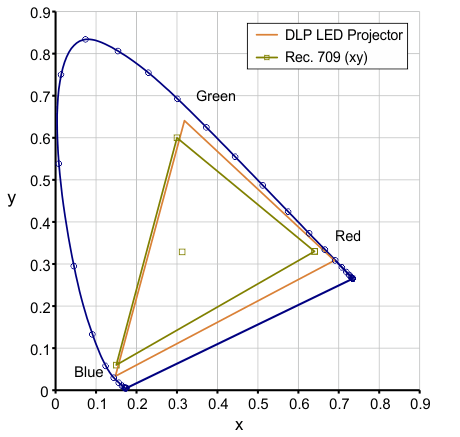DLPA078B February 2017 – September 2021 DLP160AP , DLP160CP , DLP2000 , DLP2010 , DLP230GP , DLP230KP , DLP230NP , DLP3010 , DLP3310 , DLP4710 , DLP471TP , DLPC3420 , DLPC3421
- Trademarks
- 1 Introduction to Optical Modules
- 2 Use Case Considerations
- 3 Core Optical Module Specifications
- 4 Additional Optical Module Specifications
- 5 Features Implemented in Software
- 6 Hardware Integration Considerations
- 7 Business Considerations
- 8 Example Optical Module Specification Table
- 9 Get Started with Development
- 10Revision History
4.3 Color Management
The color gamut of a display system defines the extent of colors that can be produced by the display. This extent is defined by the three additive primary colors: red, green, and blue. In the case of an LED-illuminated optical module, these colors are controlled by the color of the individual LEDs and any filters in the system. The color gamut is traditionally plotted in the 1931 CIE chromaticity space.
ITU-R Recommendation BT.709 (commonly known as Rec. 709) is a common HDTV color gamut recommendation created by ITU (International Telecommunications Union). It is possible for an LED-illuminated DLP projection system to achieve a wider color gamut than Rec. 709 (see Figure 4-1).
DLP Pico projection optical modules can produce variable white points and color temperatures, which can be adjusted by the optical module manufacturer and programmed into different modes (e.g. cool, normal, warm) in the final product. Note that the brightness specification of an optical module can vary depending on the white point. If color accuracy is a key requirement of the final product, it is recommended to specify a target white point, for example Illuminant D65 (1).
 Figure 4-1 Color Gamut
Figure 4-1 Color Gamut